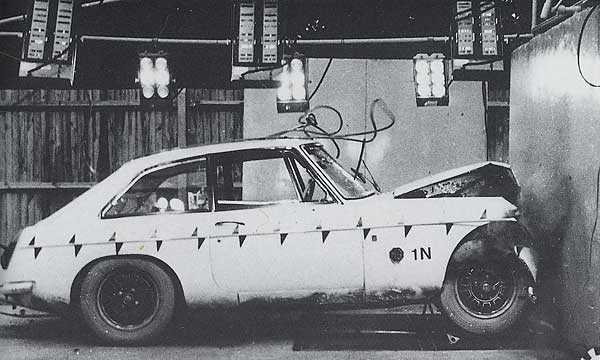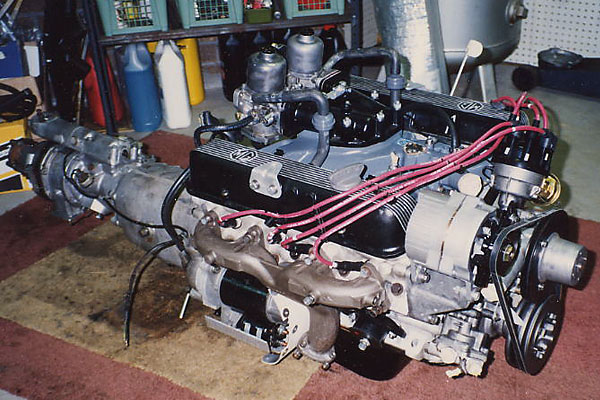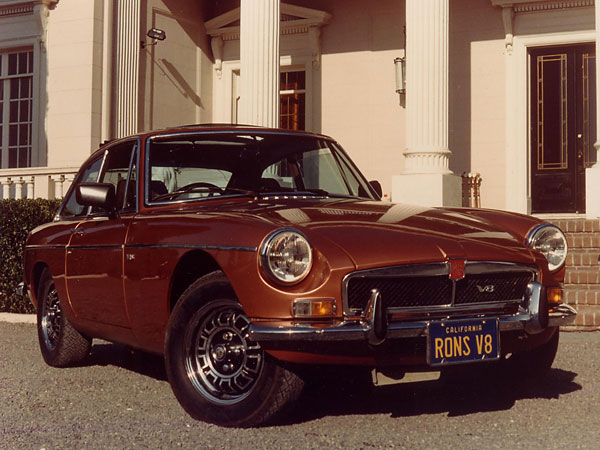
Not to be published until Wednesday 15th August 1973
MGB GT V8
DEVELOPMENT OF THE BODY AND THE ENGINE
The engine and the body structure of the new MGB GT V8 were both seen by the public in 1965. In the Spring Rover engineers showed to a few selected journalists a 3 litre saloon with a new type of light alloy V8 engine installed and the new MGB GT was unveiled at the London Motor Show of 1965 as a new Grand Touring car.
THE ENGINE
Technology these days is international and Rover did not hesitate to look across the Atlantic when, in the early 'sixties they were looking for a new powerplant to take their range into the 'seventies. The engine they chose had the merits of lightness and compactness, but needed development to meet European needs. Despite the robust five bearing crankshaft and the excellent breathing possibilities inherent to the layout, engine speeds over 4,800 rpm showed up stresses in the pistons and the valve gear.
Manufacturing technology at the Rover plant was not geared to the methods of
construction used by the engine's original designers and new methods of thin-wall
aluminum casting had to be evolved to make it. A development programme was put in
hand to develop appropriate methods of construction and to bring the engine to European
standards of output and engine speed.
The original engines developed 150bhp gross at 4,400 rpm and by the middle of 1967
Rovers had installed twin carburetters, reduced the compression ratio slightly and
achieved 160 bhp gross. By the time the Rover 3500 appeared in production in 1968,
power was up to 184 bhp gross at 5,200 rpm with outstanding reliability and very
long life.
New pistons, and different materials for the valve train as well as for the bearing
inserts and for the crankshaft, had been evolved during the search for these improvements.
As installed in the MGB GT V8, the unit has few changes. The most notable are the
repositioned carburetters and the alternator. With increasingly tough emission and
pollution regulations now rigorously applied in many parts of the world, MG engineers
were concerned to make certain that their new engine complied with all possible
requirements. A reduction in compression ratio, which is now 8.25:1, is a direct
result of this concern. The 137bhp now claimed for the engine is measured by methods
comparable to those applied in the DIN rating.
THE STYLING
The good looks of the MGB GT body made an immediate impression when the model was
launched in October 1965. Evolved from the MGB at Abingdon, it was refined by Pininfarina
stylists, consultants to MG, who gave the car its timeless appearance. This new model
became accepted as undeniably the best looking of a visually related trio which included
the Mini and the Austin 1100/1300. It has been found necessary to make only very few
amendments to improve the appearance over the years, but the USA Safety Act of 1966
and the Clean Air Act of two years later involved an extended and costly programme to
evolve structures and equipment capable of meeting the provisions of these new
regulations in a very important market.
(c)
Enjoying this article? Our magazine is funded through the generous support of readers like you!
To contribute to our operating budget, please click here and follow the instructions.
(Suggested contribution is twenty bucks per year. Feel free to give more!)

30mph barrier testing of the MGB GT V8 model. (Note the distinctive "V8" wheels.)
Editorial Comments:
Without doubt, part three of the five part press release is the weakest link in that chain.
What committee wrote this? Consider the engine section: of course the writers didn't want
to say anything bad about Rover or anything good about General Motors, but they missed a
fine opportunity by failing to note that the aluminum V8 engine in this new sports car
already had a spectacular racing history, having competed in the Indy 500 and having won
outright (albeit with substantial modification) two Grand Prix championships. They chose
instead to imply misleadingly that GM had only been able to get 150bhp gross out of the
engine, when in fact GM had offered many variants of the engine right up to 215hp (with a
turbocharger, in Oldsmobile "JetFire" trim.) On the other hand, Rover engineers had detuned
the engine to just 137bhp DIN (and 8.25:1 compression) for the Range Rover and MGB GT V8.
The "Styling" section is especially odd. Why would anyone compare MGB GT's elegant
Pininfarina styling to the Mini or the Austin 1100 / 1300? Even more bizarre, why whine
so pathetically about the USA Safety Act of 1966 or the USA Clean Air Act - especially in
this section? (Neither act had anything at all to do with the styling of the 1973 MGB GT V8.)
Ironically, this section ends by describing the U.S. as "a very important market". This is
ironic because the decision had already been made by British Leyland management that the
MGB GT V8 would never be offered in North America! In effect, this left the door wide
open for sales of the Datsun 240Z and then 260Z (with their inline 6 engines) to grow
unchecked by British competition. The Ford Mustang II, which started production in 1974,
wasn't available with a V8 engine in its first model year. When the oil embargo hit (on
October 17, 1973), and panicked Americans started trading-in their muscle cars, MG was
unprepared to capitalize on the surprisingly good gas mileage of the MGB GT V8.

Ken Smith's aluminum V8 engine complete with MG valve covers, manifolds, and gearbox.
Notice that MG used a Delco (GM) alternator. As with the Rover 3500S, which was already
being sold in North America, GM would have been paid a nice royalty for every MGB GT V8
sold here. Components like the Delco alternator would also have favored GM's bottom line.

Ron Hall's MGB GT V8, photographed in 1981 at Lido Mansion in California.
This is one of about twenty factory MGB GT V8s that immigrated to the U.S.A.
Disclaimer: The "editorial comments" and photo captions were written by Curtis Jacobson. Views expressed are those of the author, and are provided without warrantee or guarantee. Apply at your own risk.
This article is part of a set of FIVE! If you enjoyed this article, check out:
MGB GT V8 Press Release - Introduction
MGB GT V8 Press Release - "Description of the Car"
MGB GT V8 Press Release - "Grandest Tourer - Latest of a Line"
MGB GT V8 Press Release - "Technical Specifications"
BritishV8 Magazine has assembled the largest, most authoritative collection of MG "MGB GT V8" information you'll find anywhere. Check it out! Access our MGB GT V8 article index by clicking here.

